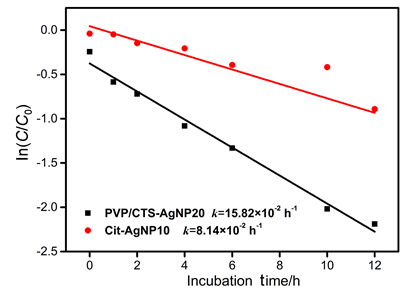摘要/Abstract

纳米银由于具有优良的杀菌性能,越来越多地用到饮用水消毒等领域.其作为杀菌剂主要针对饮用水中细菌超标以及水处理膜组件中存在的膜污染(菌污染)等问题.然而,由于AgNPs具有良好的光催化活性,可能会影响水处理系统中共存无机砷[As(Ⅲ)和As(V)]的形态转化.本研究采用液相色谱-电感耦合等离子质谱联用技术(HPLC-ICP/MS)测定As(Ⅲ)和As(V),系统考察了水相中AgNPs对As(Ⅲ)和As(V)的吸附性能,体系pH值、NOM及共存离子(以Ca2+为例)等环境因素以及AgNPs的粒径和包覆剂等对As(Ⅲ)形态变化的影响.结果表明,AgNPs对As(Ⅲ)不存在物理吸附,但对As(Ⅲ)的氧化具有明显的催化作用.体系pH大于7.0时,AgNPs开始呈现对As(Ⅲ)氧化的显著催化作用,NOM、Ca2+、光照等环境因素均在一定程度上促进As(Ⅲ)的形态转化.此外,该过程与AgNPs本身的性质密切相关,粒径越小其催化性越好,PVP/CTS包覆AgNPs对As(Ⅲ)的催化氧化反应速率常数(k=15.82×10-2 h-1)为柠檬酸包覆AgNPs的2倍.最后,在实际环境水样中验证了AgNPs对As(Ⅲ)的催化氧化.以上研究结果表明,水处理系统中的AgNPs在杀菌抑菌的同时,还能够促使As(Ⅲ)向低毒As(V)的转化,为As污染的去除提供了新的思路.
关键词: 砷, 纳米银, 催化氧化, 环境因素
With the development of nanoscience and nanotechnology, nanomaterials have been applied in many areas including environments. Silver nanoparticles (AgNPs) are being widely used in drinking water disinfection due to their excellent bactericidal performance. As the bactericide, AgNPs could minimize or eliminate bacteria exceeding standards and water treatment membrane fouling. Arsenic contamination, especially in the underground water, has gained great attention from the environmental science community, demanding effective methods to eliminate or remove more acutely toxic inorganic species[i.e., As(Ⅲ) and As(V)]. Given the good photocatalytic activity, AgNPs could have an impact on the transformaiton of As(Ⅲ) and As(V). In this study, high performance liquid chromatography (HPLC) coupled with inductively coupled plasma mass spectrometer (HPLC-ICP/MS) were used to investigate the effects of some environmental relative factors like pH, natural organic matter, cation ions (e.g., Ca2+), and the intrinsic properties of AgNPs like size and coatings, on the conversion of the two main inorganic arsenic[As(Ⅲ) and As(V)] in the aqueous solution in the presence of AgNPs. It was found that AgNPs showed no physical adsorption for As(Ⅲ), while resulted in significant catalytic oxidation of As(Ⅲ) into As(V). Moreover, environmental factors including pH, sunlight, NOM, Ca2+, and properties of AgNPs (e.g., size, coating) showed significant effects on the catalytic oxidation of As(Ⅲ). The catalytic oxidation was also confirmed in the real environmental waters. Finally, the catalytic ability of AuNPs and AgNPs were compared to unveil the mechanism of catalytic oxidation of As(Ⅲ) by AgNPs. In addition to oxidation of superoxo or peroxo species formed due to activation of molecular oxygen by the electron transfer from negatively charged AgNPs, the redox potential of silver (φΘAg+/Ag0=0.80 V) mostly contributed to the transformation of As(Ⅲ) into As(V). Therefore, given the coexisting of As(Ⅲ) and AgNPs in the water treatment system, AgNPs could play dual function in both sterilization and detoxification of As(Ⅲ), which paved the novel way to effectively treat As contamination.
Key words: arsenic, silver nanoparticles, catalysis, environmental factors References
PDF全文下载地址:
点我下载PDF
